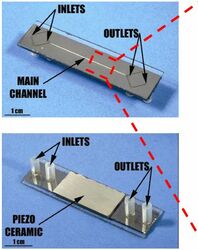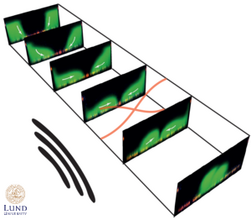Acoustofluidics

The acoustic radiation force
Sound can exert forces on tiny objects if they have material properties that are different from those of the surrounding medium. These forces stem from sound scattering and will set an object in motion if it is freely suspended in a fluid. The effect scales with frequency and becomes prominent for sound waves in the MHz-range. The sound wavelength are in this range of frequencies of less than one millimeter and therefore the technology is suitable to implement on the microscale. By exposing a suspended cell to a standing sound wave inside a microfluidic cavity forces on the order of pN can be generated leading to acoustic migration velocities of millimeters per second. For reference, one millimeter corresponds to 100 times the cells size.

Acoustic streaming
Acoustic streaming is a steady fluid flow that is caused by dissipation of acoustic energy. One kind of acoustic streaming, referred to as Rayleigh streaming, causes a conveyor belt-like motion of fluid inside a thin viscous boundary layer on the interior walls of acoustofluidic resonators. This boundary-driven streaming flow then recirculates via the bulk of the cavity and the fluid is slowly mixed.
Acoustic streaming is one of the major limiting factors when it comes to the smallest size of particles that can be manipulated using acoustic fields. Small particles experience weak acoustic radiation forces and will therefore be dragged along in the streaming field and are therefore challenging to control by acoustic fields.
In an ongoing research project we address this limitation and we have recently shown that acoustic streaming can be efficiently suppressed by alterations of the suspending media.
The acoustic body force in fluids

Inhomogeneities in the material properties of a fluid inside and acoustic cavity will lead to a buildup of acoustic body forces. For example, if a fluid of high density is flowing through the cavity alongside a fluid of low density, a fraction of the sound will scatter at the interface region between the two fluids. This scattering force can for some constellations cause rapid reorganization of the two liquids with respect to the sound field as can be seen in the illustration and movie [Deshmukh et al., Lab on a Chip, 2014, Karlsen et al., Physical Review Letters, 2016 (PDF) and Karlsen and Bruus, Physical Review Applied, 2017 (PDF)].
Focusing sub-micron particles
Direct and precise manipulation of sub-micron particles such as bacteria, platelets, organelles, microvesicles, exosomes or virus particles is challenging. Conventional acoustophoresis is limited to particles that are larger than approximately 2 µm in diameter because of acoustic streaming [Qiu et al., arXiv.org, 2020 (PDF)].
We were first to show how acoustic streaming in the bulk can be efficiently reduced by introducing a density or compressibility gradient. This enabled focusing of 500-nm-diameter particles in a standard acoustophoresis channel [Augustsson, µTAS 2016 Conference, Dublin (PDF)].
In a theoretical and experimental work we were first to describe how acoustic streaming can be efficiently suppressed by forming a gradient in the material properties (density and compressibility) across the acoustic cavity. [Karlsen, Physical Review Letters, 2018 (PDF)]
We later provided experimental evidence that this effect is present for inhomogeneities in material properties of less than 1%. [Qiu, Physical Review Applied, 2019 (PDF)]
We recently showed this approach can be used to efficiently isolated bacteria from blood by selective lysis and subsequent separation of bacteria from lysate debris and released hemoglobin Van Assche, Scientific Reports, 2020.
References
[Augustsson, µTAS 2016 Conference, Dublin (PDF)]
[Karlsen, Physical Review Letters, 2018 (PDF)]
[Qiu, Physical Review Applied, 2019 (PDF)]
[Van Assche, Scientific Reports, 2020]
[Qiu et al., arXiv.org, 2020 (PDF)]
[Deshmukh et al., Lab on a Chip, 2014]
